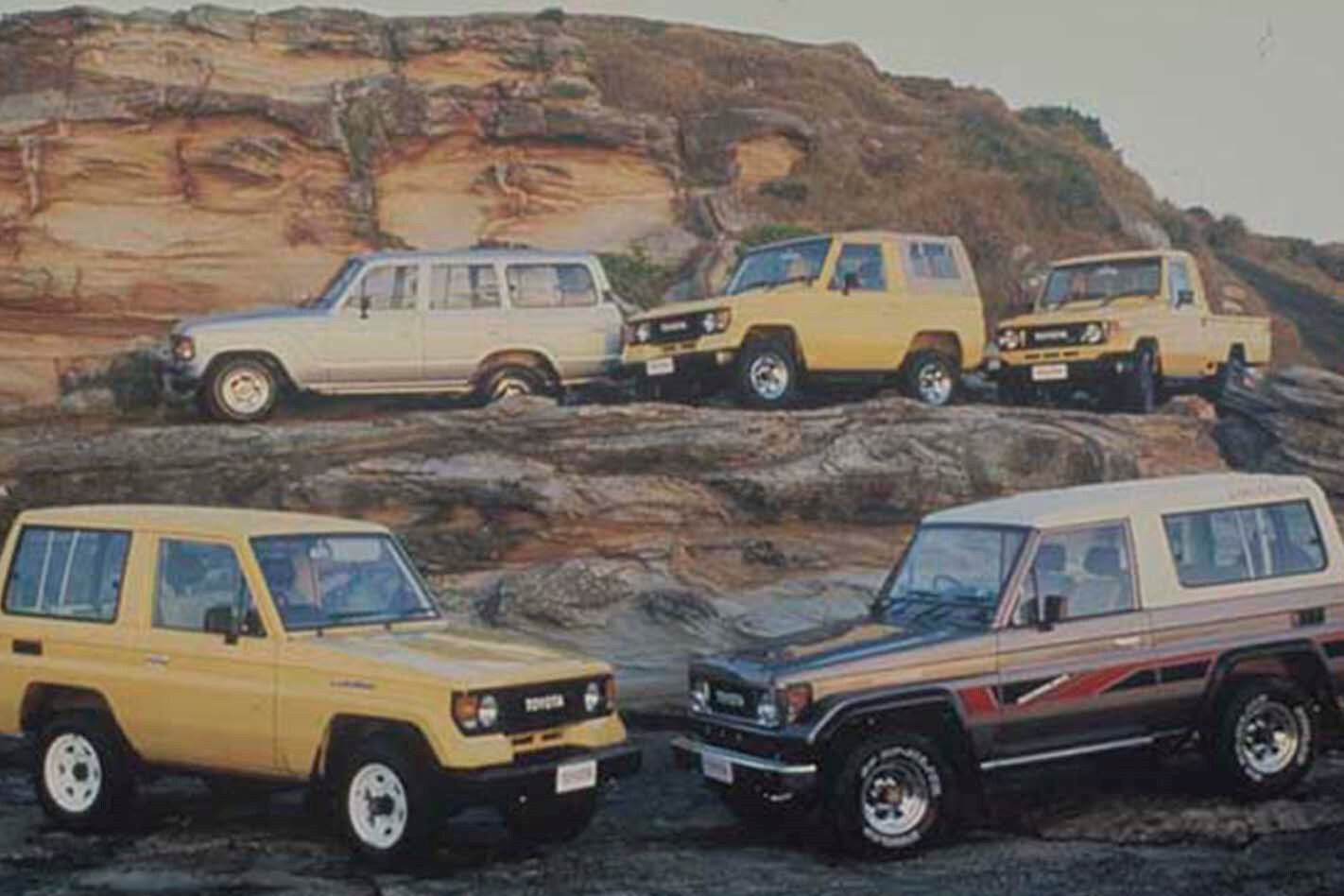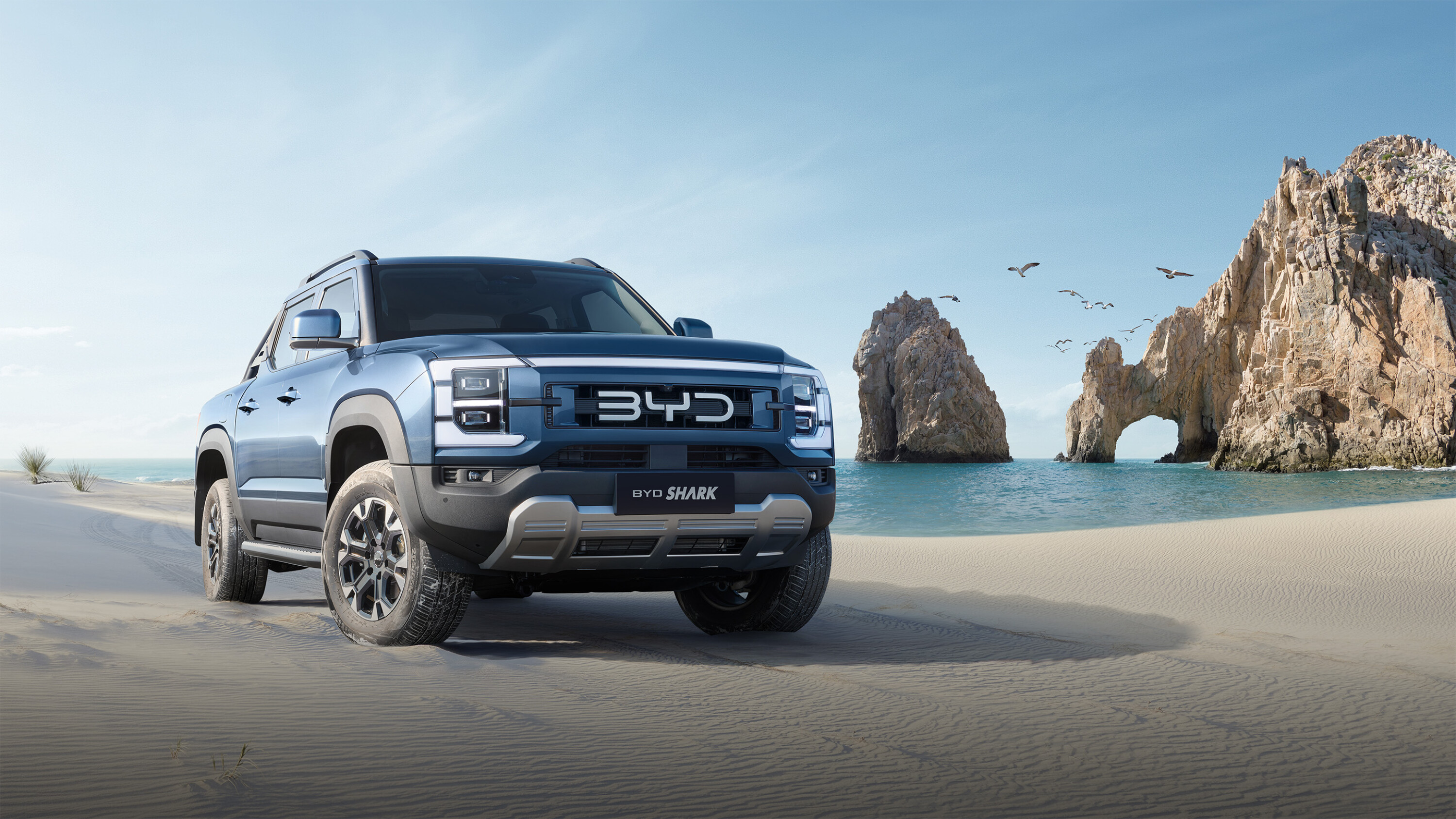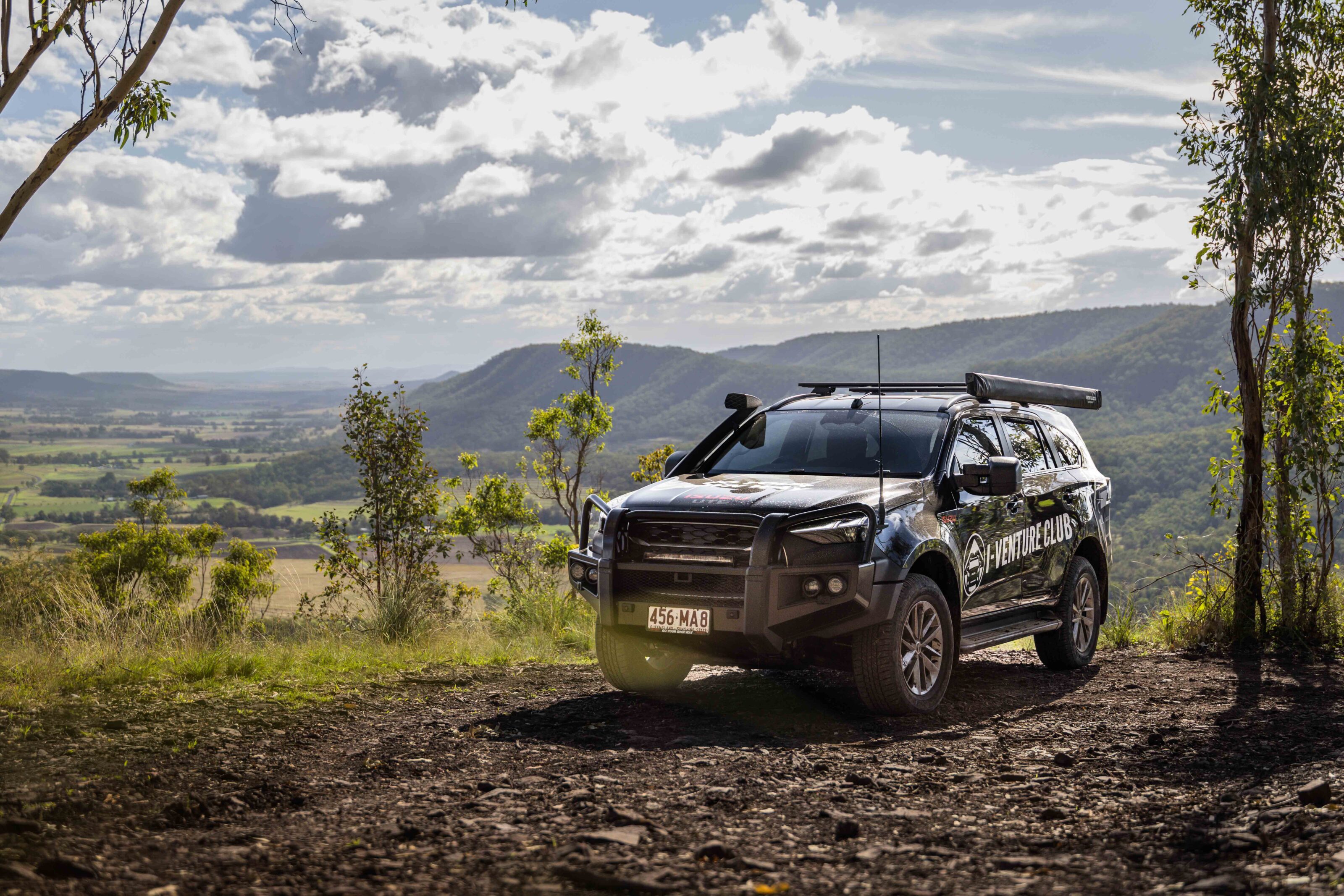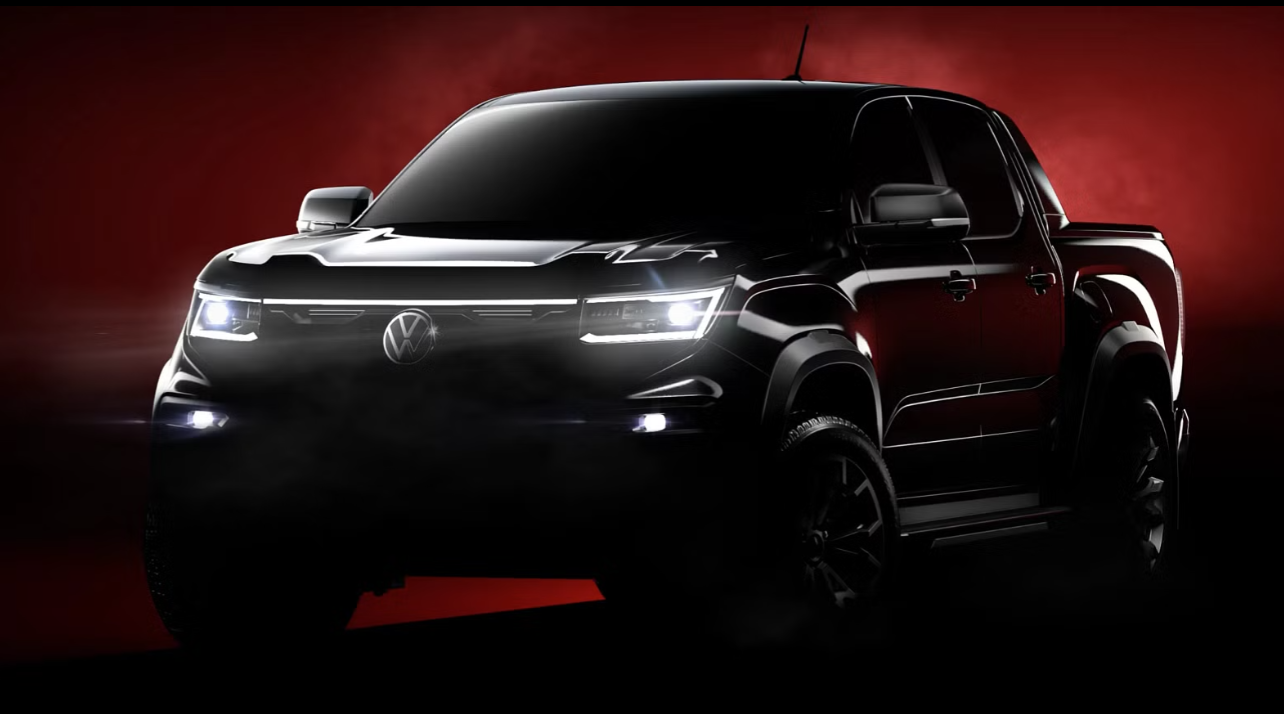The Land Cruiser 70 Series has just turned 30. We take a look at its past, present and future.
Land Cruiser beginnings
The year was 1984 and The Cosby Show was a ratings winner, the first Apple Mac had just been unveiled, Bruce Springsteen was Dancing in the Dark and Scarlett Johansson, Katy Perry and Mark Zuckerberg were in nappies. Oh, and Toyota launched the Land Cruiser 70 Series.
Many four-wheel drives have a long model cycle but I doubt when it was launched in the era of big, curly bouffant hairstyles and spandex miniskirts that anyone would have predicted the 70 Series would still be in production in 2014. By the time the 70 Series came along, the Toyota Land Cruiser had already built a solid reputation as a tough, no-nonsense 4WD that could be relied upon in Australia’s harsh environment. Leslie Thiess (later Sir Leslie) imported the first Toyota Land Cruiser 20 Series to Australia in 1958, and subsequently put 13 of the vehicles to use on the Snowy Mountains Scheme.
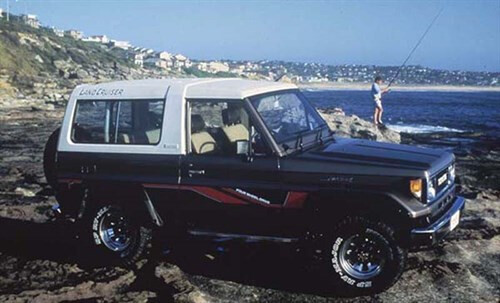
In February 1961, Thiess (Sales) Pty Ltd was appointed sole importer of Toyota automotive products for Australia, and over the next few years it built up an impressive sales and service network throughout the country. It wasn’t long before the ubiquitous Land Cruiser 40 Series became a favourite with industry and farmers alike, as well as those who wanted a simple, robust and reliable vehicle to take them to remote parts of Australia.
By 1980, the 40 Series was 20 years old and it was starting to show its age; it had remained virtually unchanged throughout its model life and was about to lose sales to a more modern competitor from Japan, the new Nissan MQ Patrol, which was offered in short- and long-wheelbase wagon variants, as well as in ute form. To counter the MQ wagon, Toyota launched the Land Cruiser 60 Series in 1981, but it still relied on the ageing 40 Series to hold onto its share of the commercial and short-wheelbase market for the next few years… until the launch of the 70 Series at the end of 1984.
The 70 Series’ chief engineer Masaomi Yoshii was mindful that the new Land Cruiser should not sacrifice any of its toughness, so it was based on a strong ladder-frame chassis with live axles and leaf spring suspension. The angular 70 Series was quite a modern-looking design back in the 1980s, and it was more comfortable and better appointed than its predecessor, and featured a stronger and more rigid box-section chassis.
However, in typical conservative Toyota fashion, the styling wasn’t too much of a departure from the previous generation – despite the 70 Series’ very angular bodywork, the new Cruiser retained externally added fenders and a relatively flat windscreen that gave it a strong family link with the 40 Series, although it also had some modern features such as curved glass.
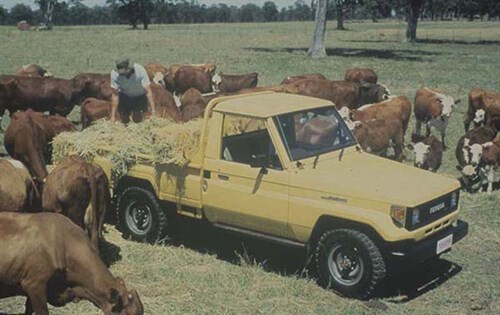
Models, models and more models
The 70 Series was initially offered in a range of body styles and chassis configurations with a wide selection of petrol and diesel engines to ensure it had access to every nook and cranny of the commercial 4WD and recreational 4WD market.
The short-wheelbase FJ70/BJ70 was available as a soft-top or van; the mid-wheelbase FJ73/BJ73 with a fibreglass reinforced top (FRP); and the long-wheelbase FJ75/HJ75 as a pick-up, cab-chassis or TroopCarrier. In addition, there was a coil-spring variant of the short-wheelbase model called the Bundera (RJ70), which also had lighter-duty HiLux running gear.
In the long-wheelbase ute, cab-chassis and Troopie models, the 2H diesel engine was carried over from the 40 Series – a 4.0-litre, six-cylinder, overhead valve donk (76kW/240Nm) – while the 3F 4.0-litre OHV petrol engine (110kW/303Nm) was a revised version of 40 Series’ 2F powerplant.
The 3F was also available in the short- and mid-wheelbase models (FJ70, FJ73 and RJ70 Bundera Deluxe), but the base-spec powerplant in the RJ70 Bundera was the 22R 2.4-litre four-cylinder petrol engine (74kW/174Nm).
A 3B 3.4-litre four-cylinder diesel engine (67kW/217Nm) was also offered in the short- and mid-wheelbase BJ70 and BJ73 models respectively. In 1986 the 2.4-litre petrol engine was offered with optional fuel injection, and a 2LT 2.4-litre turbodiesel engine (64kW/188Nm) was introduced in the Bundera (LJ70). A 13B-T 3.4-litre turbodiesel engine (91kW/285Nm) was now used in the mid-wheelbase BJ74 and the naturally aspirated 3.4D could be had in the BJ70 Bundera. It was as though Toyota wanted to offer a 70 Series to everyone. The cab-chassis and Troopie variants proved the most popular however, with industry and private buyers. The 75 models were reasonably comfortable, had decent performance, excellent offroad capabilities and were offered with options such as air conditioning, diff locks, a snorkel and long-range 90L fuel tank (in addition to the 90L main tank).
A payload that was in excess of 1000kg made these vehicles ideally suited to long-distance, remote-area travel, and it wasn’t long before Troopies were being converted into offroad campers.
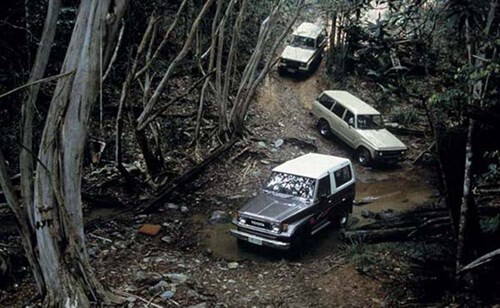
Bye, bye, Bundy
A significant upgrade in March 1990 was the introduction of the venerable 1HZ OHC 4.2-litre diesel engine (96kW/285Nm), an engine that would see service in the 70 Series for the next 17 years. Of far less significance was the introduction of the 1PZ 3.5-litre five-cylinder diesel engine (72kW/221Nm) that saw service in the short and mid-wheelbase PZJ70RV and PZJ73RV models respectively.
By 1991, the writing was on the wall for the smaller Cruisers and Toyota Australia dropped the coil-spring Bundera from the 70 Series line-up, as well as all of the mid-wheelbase models, leaving just the short-wheelbase FJ70RV/PZJ70RV to sell alongside the long-wheelbase 75 models.
By 1993 the shorty had been deleted from the 70 Series line-up for good, but the 75 Series was now available with the 1FZ-FE DOHC 4.5-litre six-cylinder petrol engine (158kW/373Nm), making it the most powerful 70 Series to date. It was the far more economical 1HZ 4.2-litre diesel, however, that was a favourite with industry, farmers and remote-area travellers, not just for its better fuel economy, but also its simplicity and reliability.
Despite all of the engine changes and a few equipment and trim upgrades from 1985 to 1993, the Land Cruiser 75 was essentially the same vehicle that had been launched eight years earlier, and it remained that way for the next six years until the launch of the 78/79 models in October 1999.
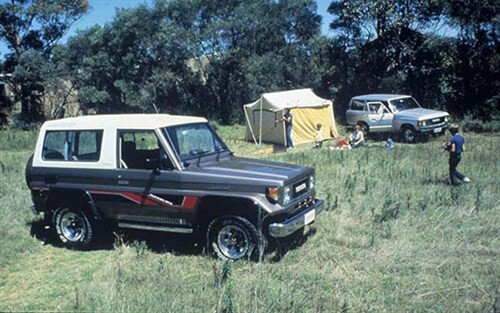
Bundera
THE Bundera was essentially a light-duty short-wheelbase version of the Land Cruiser 70 Series. It was the first coil-spring Toyota 4WD and its five-link suspension system would eventually be used in the Land Cruiser 80 Series wagon launched several years later. The drivetrain in the Bundera was the same as that used in the HiLux of the day, including engine options and differentials. The Bundera also had distinctive front-end styling with a wider grille and integrated indicators. However, the downfall of the Bundera was that the coil-spring suspension didn’t work so well with the vehicle’s short wheelbase and, on the road, it exhibited significant pitching and rolling, leading to it being dubbed the ‘Blundera’ by many at the time. Off road, the Bundera was far more effective, and fitted with quality aftermarket suspension it would even behave respectably on the road. Unfortunately for the Bundera, and for the other short- and mid-wheelbase 70 Series models, three-door 4WDs never proved as popular in Australia as their more practical five-door counterparts, and all of these models were dropped from the 70 Series line-up by 1993.
A new era
It’s difficult to overstate the improvement in ride and handling heralded by this upgrade. Those used to the bone-jarring ride of the all-leaf-spring models over rough surfaces were in for a real treat; the front-end revisions resulted in vastly improved steering precision and reduced body roll while the longer leaves at the rear improved ride quality both when laden and unladen.
Modern Turbodiesel
The recreational 4×4 ute boom was still in its infancy in 2001 and while many cockies and miners were quite content with the 70 Series’ naturally aspirated 1HZ diesel engine, Toyota could see that private buyers would appreciate an oil burner with a bit more grunt.
Toyota was also facing some stiff competition in the form of Nissan’s 4.2-litre turbodiesel GU Patrol and Ford’s new turbodiesel F250, available with six- or eight-cylinder turbodiesel engines. Enter the 1HD-FTE in 2001 – a 4.2-litre OHC six-cylinder turbodiesel engine (122kW/380Nm) available in both the 79 cab chassis and the 78 Troopie.
The new turbodiesel powerplant, pinched from the 100 Series wagon minus the intercooler, offered similar performance to the still available 4.5-litre petrol engine, without the penalty at the fuel bowser. Mated to the top-of-the-range RV spec, the 70 Series now offered comfort as well as performance, with standard features such as cloth-covered bucket seats, carpet, remote central locking, power windows, a CD player and even alloy wheels (on the 79).
For those after something a little more basic, the 1HZ diesel engine was still available in spartan base-spec models.
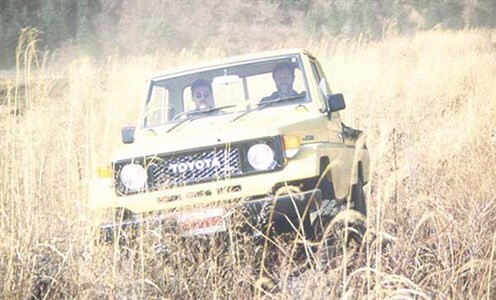
The mighty TDV8
Arguably the biggest revamp of the 70 Series took place in 2007 with the introduction of the 1VD-FTE 4.5-litre V8 turbodiesel engine. Although it remained essentially unchanged from the A-pillar back (other than the introduction of the 76 Series wagon to the line-up), the front-end of the 70 was redesigned to accommodate the new TDV8 engine and to give it a more modern look – gone were the externally added fenders, and a whopping big scoop sat in the middle of the bonnet for the top-mounted intercooler.
Considering its 4.5-litre capacity, the TDV8 offered relatively modest peak outputs of 151kW and 430Nm, but the claimed torque peak was available from as low as 1200rpm all the way through to 3200rpm, making this a seriously tractable engine perfectly suited to the 70 Series. Toyota even claimed an improvement in fuel economy compared to the superseded 4.2-litre six-cylinder turbodiesel engine. Other changes with the 2007 model update included revisions to the chassis, a wider front track, minor suspension upgrades and a new steering pump, all aimed at refining handling, stability and comfort levels. Noise and vibration levels were also addressed with the introduction of a new front floor panel and a new front body silencer, a reinforced gearshift lever aperture, a bonnet silencer, dash inner and outer silencers and apron seals.
When the new model range was launched, both the 1HZ diesel and the 4.5-litre petrol engine were dropped from the line-up, making the 70 Series the diesel-only proposition that it is today. The 79 cab-chassis and the 78 Troopie were each available in three spec levels and the new 76 wagon was available in two spec levels. None were yet available with ABS or SRS airbags.
Despite the lack of safety features, the 76 was an immediate hit with recreational 4WDers who wanted a no-nonsense, live-axle, four-door 4×4 wagon with seriously capable offroad ability, decent load-carrying capacity, a powerful yet frugal powerplant and something not as big as a Troopie.
For many, the 76 represented all that the Land Cruiser wagon once was – the 200 Series wagon, with its ever-decreasing payload capacity, independent front suspension and complicated electronic traction control, was no longer seen as a viable vehicle for long-distance, remote-area travel. The 76 wagon filled that gap and Toyota even offered an up-spec GXL variant for that very reason.
The current line-up
The current 70 Series line-up was introduced in August 2012 and, as well as SRS airbags, included the addition of ABS. The new model was essentially engineered to appease the big mining companies that had introduced strict OH&S policies relating to the safety equipment on vehicles that their employees could operate. As well as adding ABS, Toyota took the opportunity in 2012 to introduce a new 79 double cab model. At the time of its launch, Matthew Callachor, executive director sales and marketing Toyota Australia, said the Land Cruiser double cab was developed as a direct result of the company’s long-term commitment to the mining and rural sectors.
Two model grades are currently offered in double cab, TroopCarrier and wagon variants (WorkMate and GXL) while the single cab chassis has three model grades (WorkMate, GX and GXL) giving a total of nine models in today’s 70 Series line-up. Compared to the original 70 Series, the current GXL grades are positively luxurious, with features such as the aforementioned ABS and SRS airbags, standard diff locks (optional on GX), remote central locking, power windows and alloy wheels (except Troopie). All grades are equipped with a sound system featuring Bluetooth connectivity and voice recognition, and the new interior offers height- and reach-adjustable steering wheel, a neat and functional dashboard design (with a cupholder) and reasonably comfortable, cloth-covered bucket seats on many models.
Despite all of the changes over the years, the Land Cruiser 70 Series still retains all of the attributes that have always made it such a versatile offroad vehicle in Australia: excellent ground clearance, a tough box-section separate chassis, live-axle suspension, a simple part-time 4WD system with manually locking hubs, good low-range gearing, good load-carrying capacity, good touring range, a variety of body styles to suit different uses, and, most importantly, an unequalled dealer network with service and back-up all over the country.
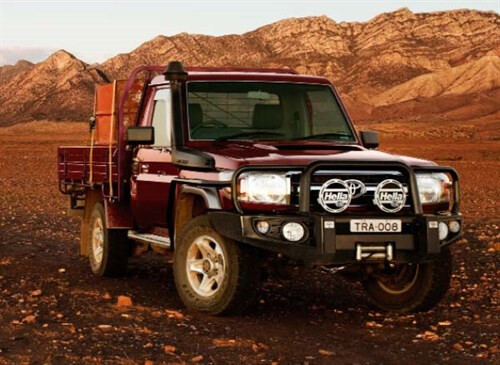
What’s next?
So what’s next for the venerable 70 Series Land Cruiser? Does it look as though the legendary workhorse might be retired in the next few years?
Big mining companies such as BHP, which make up most of the fleet sales for the 70 Series in Australia, have introduced mandatory five-star safety ratings for vehicles on their fleets and, even with the introduction of ABS and SRS airbags, the 70 can’t meet this requirement without stability control and a full complement of airbags. In fact, Toyota even admitted that it would not have bothered developing the 79 double cab model had it known this five-star requirement was to be introduced.
Nevertheless, 70 Series sales are still strong in Australia. “Last year almost 20 per cent of the global 70 Series volume was sold within the Oceania Region,” Toyota Australia product public relations manager Stephen Coughlan told 4X4 Australia. “The vehicle remains popular within the Middle East, Africa and Australia. The single cab chassis is easily the most popular model in the 70 Series line-up in Australia but the new double cab is also popular. Since its local introduction, the double cab has been particularly well received. Whilst the bulk of 2013 sales (53 per cent) were, not surprisingly, the single cab, the double cab accounted for 34 per cent of the mix, followed by the wagon (seven per cent) and TroopCarrier (six per cent).”
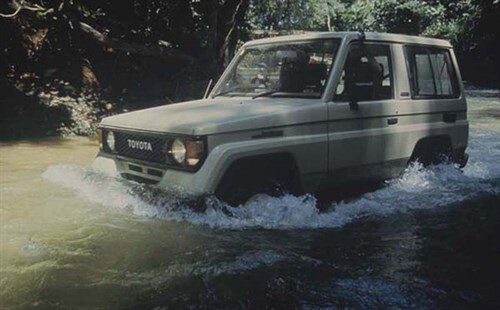
Exactly how much longer the 70 Series will remain in production is anyone’s guess, but it certainly has a few years left in it yet. “I can confirm that the Land Cruiser 70 Series remains a work in progress and will continue to be for years to come,” Stephen said. “Last month Toyota Japan commemorated the 30th Anniversary for the start of global production for the 70 Series and to mark the occasion they’ve reinstated the model to the Japanese line-up for a period of around one year. The press release heralding this initiative has sparked a renewal of interest in this iconic family of rugged trucks.
“Many local buyers for this vehicle are repeat purchasers, who know they’ll be able to drive the truck for years and years. The 70 Series range is almost unapologetically rugged. It’s a heavy-duty workhorse and whilst some may suggest it lacks some of the creature comforts, many owners tell us this is something they find endearing. Lockable hubs, a lever-style transfer, long-range fuel tanks – all make the vehicle a straightforward, go-anywhere machine.”
More 4×4 Australia news and reviews.
Subscribe today to keep up to date on all the latest 4×4 Australia news and reviews

